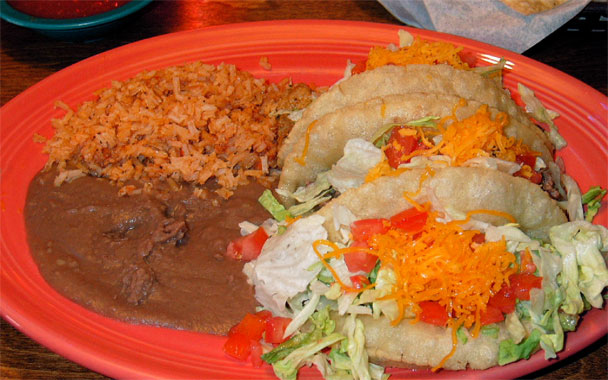The major taco classifications are already well known to us: the hard-shell taco, made from a single yellow-corn tortilla bent into a trough and fried crisp; the soft taco, a wheat-flour tortilla wrapped around fillings; and—the variety preferred in southern Mexico—a pair of floppy white-cornmeal tortillas folded over fillings. So, when a friend from San Antonio started raving about another kind of taco—the so-called puffy taco—I had to investigate.
I made my way down to Central Texas during an unusually hot week in late winter, when the temperature topped out at around 80 every day—perfect taco weather, I thought. Following my friend’s directions, I drove from my downtown hotel straight out Bandera Drive in a northwesterly direction, past innumerable gaily painted Mexican markets and taquerias. My destination was a local legend: Henry’s Puffy Tacos, an institution founded in 1976 in the West San Antonio barrio. The place had recently come up in the world by moving from its original location further out the same thoroughfare until it landed in the neighboring town of Leon Springs.
The premises might now be described as faux-rustic roadhouse, looking like a fast-food outlet looming above Interstate 410. The menu, too, is way more extensive than it must have been when the place was located in the barrio; every Tex-Mex dish and its variations are represented, in addition to hamburgers, chicken-fried steaks, and enormous salads. Inside the restaurant I found a spacious dining room on two levels outfitted with distressed and antique wood, a handsome place with a uniformed and well-trained waitstaff.
The specialty, though, remains puffy tacos. These consist of a thick flour tortilla that has been bent like a catcher’s mitt and then deep-fried; it gets crisp and creamy, and a bit greasy, too. The roster of fillings reflects the catalog that Mexican immigrants developed based upon what they could find when they reached Texas: picadillo (cumin-scented ground beef), beans and yellow cheese, carne gusada (a saucy, garlicky beef stew), chicken, guacamole, fajita beef, and fajita chicken—the latter two being extrapolations of the great Tex-Mex invention (at Mama Ninfa’s in Houston) of fajitas. In this case, “fajita” implies meat that has been dipped in chile sauce and then grilled. Though the restaurant refers to these fillings as spicy, they seemed a bit bland to me. No matter—there is plenty of spice elsewhere, including the tomato-based salsa that looks so innocent sitting next to your giant welcome-basket of chips, but turns out to be fiery beyond your wildest dreams.
The puffy tacos are really quite cute sitting side by side. In fact, it’s easy to see why a puffy taco character was invented, a smiling face wearing a tortilla coat atop a tunic of greenery. (This character also serves as the beloved mascot of the local AA baseball team, the San Antonio Missions). The tacos are topped with chopped tomatoes and lettuce; grated yellow cheese (well, not really grated, but somehow extruded in coils the size of angel-hair noodles); sour cream (rather than the Mexican standard crema, showing how Mexican immigrants substituted American products for familiar Mexican ones); and guacamole.
Though Henry’s is clearly the most famous exponent of puffy tacos, nobody is quite sure who invented them. They seem like a spontaneous creation of the area: There are puffy tacos advertised in signs painted on the exterior walls of many San Antonio Mexican restaurants. By the way, the term “Tex-Mex” is unknown here—the denizens of West San Antonio simply refer to themselves and their food as Mexican. When I visited my friend’s uncle at his meat market on West Commerce, he lamented that the cuisine was not very healthy: “It’s making people around here fat,” he said, gesturing out the window at some adipose shoppers entering the bakery next door.
Explore more forgotten cuisines of America.


